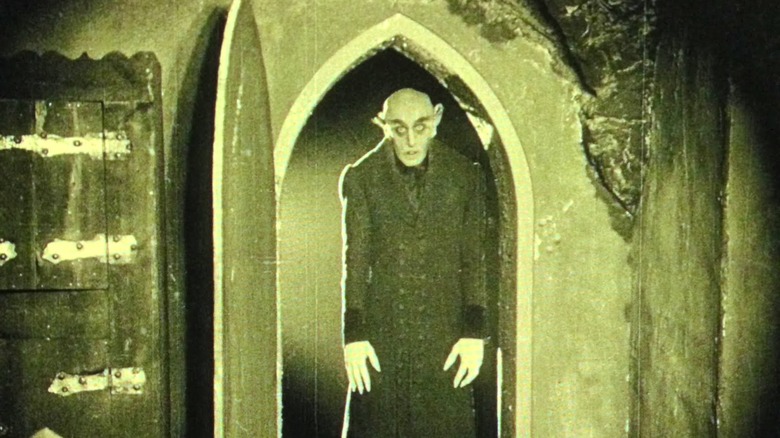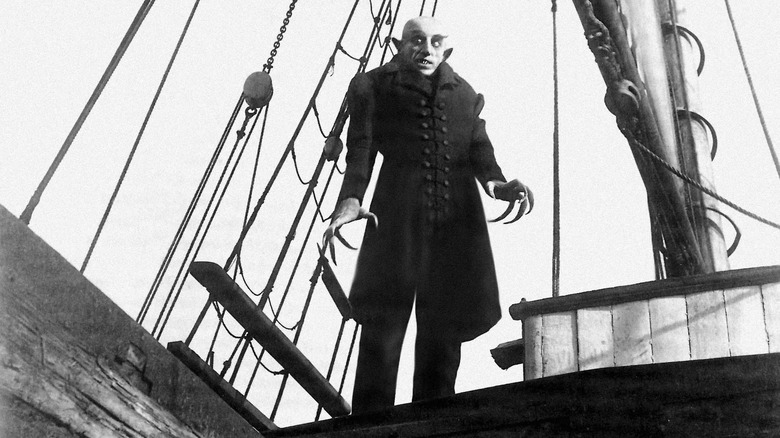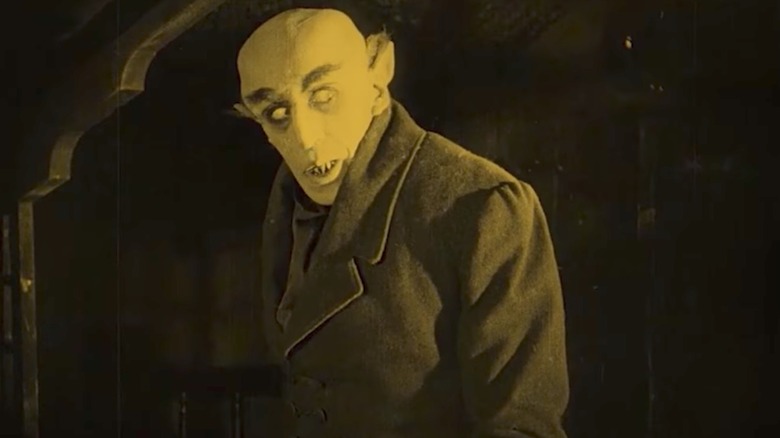A Desperate Gimmick Turned Nosferatu's Premiere Into A Disaster
Cineastes the world over know about the scandal surrounding F.W. Murnau's horror classic "Nosferatu." It's clearly an adaptation of Bram Stoker's 1897 novel, "Dracula," but Murnau infamously didn't obtain the rights to adapt Stoker's book into a screenplay. He changed the names of the characters — most notably Count Dracula was changed into Count Orlock — but that didn't stop Stoker's estate from suing Prana Film, the production company. Every copy of "Nosferatu" was ordered to be destroyed. Thanks to shiftlessness in this task, however, several prints survived, and audiences can enjoy and be terrified by "Nosferatu" to this day. For my money, it's one of the scariest movies ever made. ("The Lighthouse" director Robert Eggers is currently remaking it.)
In Rolf Giesen's 2019 book "The Nosferatu Story: The Seminal Horror Film, Its Predecessors and Its Enduring Legacy," the premiere of "Nosferatu" is described in detail, and Prana Film aimed to make it a massive gala event. Too massive, it turns out. After all the additional music and performance on either side of the movie — and even in the middle of it — everything kind of toppled over. "Nosferatu" may be an indelible classic, but "Das Fest der Nosferatu," held on March 4, 1922, didn't go over as well.
Guests were invited to gather at the Zoologischer Garten in Berlin and asked to wear costumes from the Biedermeier period (that is: ball gowns, suit tails, and smoking jackets, all taken from 1815 to 1848). While costumed guests wandered through the zoo, the overture for Heinrich Marchner's 1828 opera "Der Vampyr" was to be provided by a live orchestra. Acclaimed director Ernst Lubitsch was to be in attendance. So far, so good.
But, dear readers, there was so much more. There was to be a whole additional stage play.
Das Fest der Nosferatu, the Fyre Fest of its day
"Nosferatu," it should be noted, only runs 94 minutes at its longest, but could run as short as 63 minutes depending on the cut of the film and on how quickly the film ran through a projector; 24 frames per second didn't become a standard until the invention of sync sound, and many films ran at 16 frames per second in the 1920s. The point being, "Nosferatu" was no epic. In order to pad out the evening of the premiere, then, an entire play was written to bookend the movie.
"Das Fest" was so massive, it was almost more ambitious than the movie itself. Writer Kurt Alexander had envisioned his staged introduction as an extension of Goethe's "Faust," wherein actor Max Schreck, who played the title monster in "Nosferatu," was to explain to a trio of displaced 18th-century artists what cinema was and how the arts had evolved since Goethe's time. There was to be a singer, a theater director, and an ancient actor, each given a moment to perform. Schreck would then explain that modern filmmaking technology allowed him, as a modern man, to present almost anything the human imagination could conjure. This bold declaration would lead directly into the movie itself.
Then, halfway through the flick, there would be an intermission in which Schreck and the artists could comment on what they had seen so far. (Think of Joe-Bob Briggs on "The Last Drive-In.") The premiere would end with the director thanking Schreck for presenting such a marvelous film. The orchestra would then play a piece written by Hans Erdmann, the composer of "Nosferatu," while a pair of star ballerinas danced.
This was all weirdly ostentatious for an intimate horror film about a plague-spreading rat monster who drinks blood.
A disaster in the making
None of the above worked. For one, the makers of "Das Fest der Nosferatu" could barely erect a grand set on time, having to settle for something a lot less impressive; there were still Wonka-style disappointments a century ago. What's more, Kurt Alexander's script was said to be terrible, full of dumb, rambling, nonsensical poetry that certainly didn't evoke Goethe. The actors hired to play the singer, actor, and director opposite Schreck also weren't given enough time to rehearse, and they hadn't memorized their lines by the time they were pushed onto stage. In the words of "The Nosferatu Story," the performance was "clumsy, tiring, superfluous, and evoked displeasure."
Giesen's book also noted that the on-site orchestra also hadn't been given enough time to rehearse, leading to a rather sloppy rendition of "Der Vampyr." In short, the massive "Das Fest der Nosferatu" was a debacle, perhaps comparable to the infamous Fyre Fest of 2017. The plans were too big, the idea wasn't great, and the execution was wholly mismanaged.
Why go to all that trouble, though? Premieres don't need to be that massive. Gisen's book noted that the premiere served a specific function. It seems that the original exhibition deal for "Nosferatu" was not yet completed, and Prana Film had trouble booking it at the UFA cinemas, the largest theater chain in Germany and kind of the only one that mattered at the time. Prana Film wanted to generate hype for "Nosferatu," and felt that a massive party would be just the thing to get UFA's attention.
Needless to say, "Das Fest der Nosferatu" didn't inspire the letter-writing campaign Prana hoped for.


